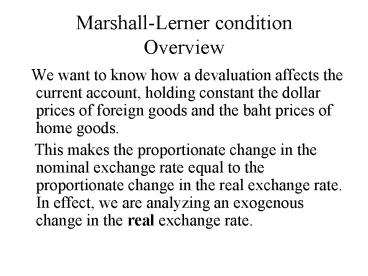MarshallLerner condition Overview - PowerPoint PPT Presentation
1 / 13
Title:
MarshallLerner condition Overview
Description:
Marshall-Lerner condition. Overview ... This makes the proportionate change in the nominal exchange rate equal to the ... This is the Marshall-Lerner condition. ... – PowerPoint PPT presentation
Number of Views:107
Avg rating:3.0/5.0
Title: MarshallLerner condition Overview
1
Marshall-Lerner conditionOverview
- We want to know how a devaluation affects the
current account, holding constant the dollar
prices of foreign goods and the baht prices of
home goods. - This makes the proportionate change in the
nominal exchange rate equal to the proportionate
change in the real exchange rate. In effect, we
are analyzing an exogenous change in the real
exchange rate.
2
Notation
- If we ignore current transfers and the
difference net factor payments from abroad, (or
if we include them in exports and imports), the
current account is - CA (P/S).X PM
- where P domestic price of exports in baht,
- P foreign of imports in dollars,
- X quantity of exports in tons of home good
- M quantity of imports in tons of foreign good
- S the exchange rate in baht/dollar.
- P/S the price of exports in dollars
3
- It is assumed that when the exchange rate is
devalued (that is, when S is increased), P and P
do not adjust in the short run. - Devaluation of the baht therefore makes Thai
goods cheaper and more competitive relative to
foreign goods. - People in Thailand see no change in the price of
Thai goods, measured in baht, but the prices in
baht of foreign goods have risen from 1 to 1.01
baht/ton
4
- For simplicity, it is assumed that we start in
a situation of current account balance with - P P S 1
- and X M 100
- CA 0.
- This makes the new value of the CA equal to the
change in the CA from the initial situation.
5
- People in the rest of the world, see no changes
in the dollar prices of their own goods, but see
a 1 fall in the dollar price of Thai goods from
1 per ton 1/1.01 0.99 per ton
(approximately) - Suppose that the absolute value of the world
elasticity of demand for Thai exports, with
respect to their relative price, is b. - Suppose that the absolute value of the Thai
demand for imports with respect to their relative
price is d. That is, a 1 devaluation reduces
imports by d.
6
- The 1 fall in the relative price of Thai goods
therefore increases exports to 100b tons and
reduces imports to 100-d tons. - CA 0.99 x (100 b) 1.(100 d)
- In practice, b and d are small numbers compared
to 100, so we can ignore the difference between b
and 0.99 b
7
- Suppose that b 3. Multiplied by 0.99 this
gives 2.97. The difference between 2.97 and 3 is
far less than the margin for error in measuring
b, so we can set 0.99b b. This gives - CA 99 100 b d
- b d - 1
8
- The current account balance improves, provided
that bdgt1. - This is the Marshall-Lerner condition.
- What you need to remember is the intuition where
does the 1 come from? - Dont worry about the approximation. In very
small changes there is no approximation.
9
The J-curve
- There is quite a lot of evidence that the
relevant export and import elasticities are low
in the short run, but much higher in the long
run. - In this case, devaluation may initially worsen
the CA, before gradually improving it. The time
path of the CA effects therefore looks a bit like
the letter J. Really, the long vertical stroke
in the letter J should have a bit of a forward
lean / to capture the effect of the gradual
improvement in the medium and long run.
10
- The next slide shows the movements in Thailands
imports and exports following the large
devaluation of the baht in 1997. - Do you think the Thai experience supports the
view that the absolute elasticities of imports
and exports are less than unity in the short-run
and higher than unity in the long-run?
11
Thailands merchandise trade (goods) (US
billion)
12
- Note that exports in dollars actually fell in
1998, despite the huge devaluation. - Even in 1999, exports in dollars were only just
back at the level of 1997. - However, by 2000, exports in dollars were 20
above the level of 1997.
13
- The big effect in 1998, relative to 1997, was the
huge fall in imports. This was partly due to the
devaluation, but also partly due to the fall
income. For the time being, we are ignoring the
effect on imports of a change in income. That
will be dealt with in the second half of the
course.































